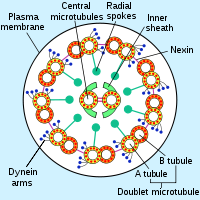
Radial spoke
Encyclopedia
The radial spoke is a multi-unit protein
structure found in the axoneme
s of eukaryotic cilia and flagella. Although experiments have determined the importance of the radial spoke in the proper function of these organelle
s, its structure and mode of action remain poorly understood.
 Radial spokes are T-shaped structures present inside the axoneme. Each spoke consists of a "head" and a "stalk," while each of these sub-structures is itself made up of many protein subunits. In all, the radial spoke is known to contain at least 17 different proteins, with 5 located in the head and at least 12 making up the stalk. The spoke stalk binds to the A-tubule of each microtubule
Radial spokes are T-shaped structures present inside the axoneme. Each spoke consists of a "head" and a "stalk," while each of these sub-structures is itself made up of many protein subunits. In all, the radial spoke is known to contain at least 17 different proteins, with 5 located in the head and at least 12 making up the stalk. The spoke stalk binds to the A-tubule of each microtubule
outer doublet, and the spoke head faces in towards the center of the axoneme (see illustration at right).
organisms lacking properly functioning radial spokes have flagella and cilia that are immotile. Radial spokes also influence the cilium "waveform"; that is, the exact bending pattern the cilium repeats.
How the radial spoke carries out this function is poorly understood. Radial spokes are believed to interact with both the central pair microtubules and the dynein
arms, perhaps in a way that maintains the rhythmic activation of the dynein motors. For example, one of the radial spoke subunits, RSP3, is an anchor protein predicted to hold another protein called protein kinase A (PKA). PKA would theoretically then be able to activate/inactivate the adjacent dynein arms via its kinase
activity.
However, the identities and functions of the many radial spoke subunits are just beginning to be elucidated.
Protein
Proteins are biochemical compounds consisting of one or more polypeptides typically folded into a globular or fibrous form, facilitating a biological function. A polypeptide is a single linear polymer chain of amino acids bonded together by peptide bonds between the carboxyl and amino groups of...
structure found in the axoneme
Axoneme
Numerous eukaryotic cells carry whip-like appendages whose inner core consists of a cytoskeletal structure called the axoneme....
s of eukaryotic cilia and flagella. Although experiments have determined the importance of the radial spoke in the proper function of these organelle
Organelle
In cell biology, an organelle is a specialized subunit within a cell that has a specific function, and is usually separately enclosed within its own lipid bilayer....
s, its structure and mode of action remain poorly understood.
Cellular location and structure

Microtubule
Microtubules are a component of the cytoskeleton. These rope-like polymers of tubulin can grow as long as 25 micrometers and are highly dynamic. The outer diameter of microtubule is about 25 nm. Microtubules are important for maintaining cell structure, providing platforms for intracellular...
outer doublet, and the spoke head faces in towards the center of the axoneme (see illustration at right).
Function
The radial spoke is known to play a role in the mechanical movement of the flagellum/cilium. For example, mutantMutant
In biology and especially genetics, a mutant is an individual, organism, or new genetic character, arising or resulting from an instance of mutation, which is a base-pair sequence change within the DNA of a gene or chromosome of an organism resulting in the creation of a new character or trait not...
organisms lacking properly functioning radial spokes have flagella and cilia that are immotile. Radial spokes also influence the cilium "waveform"; that is, the exact bending pattern the cilium repeats.
How the radial spoke carries out this function is poorly understood. Radial spokes are believed to interact with both the central pair microtubules and the dynein
Dynein
Dynein is a motor protein in cells which converts the chemical energy contained in ATP into the mechanical energy of movement. Dynein transports various cellular cargo by "walking" along cytoskeletal microtubules towards the minus-end of the microtubule, which is usually oriented towards the cell...
arms, perhaps in a way that maintains the rhythmic activation of the dynein motors. For example, one of the radial spoke subunits, RSP3, is an anchor protein predicted to hold another protein called protein kinase A (PKA). PKA would theoretically then be able to activate/inactivate the adjacent dynein arms via its kinase
Kinase
In chemistry and biochemistry, a kinase is a type of enzyme that transfers phosphate groups from high-energy donor molecules, such as ATP, to specific substrates, a process referred to as phosphorylation. Kinases are part of the larger family of phosphotransferases...
activity.
However, the identities and functions of the many radial spoke subunits are just beginning to be elucidated.

